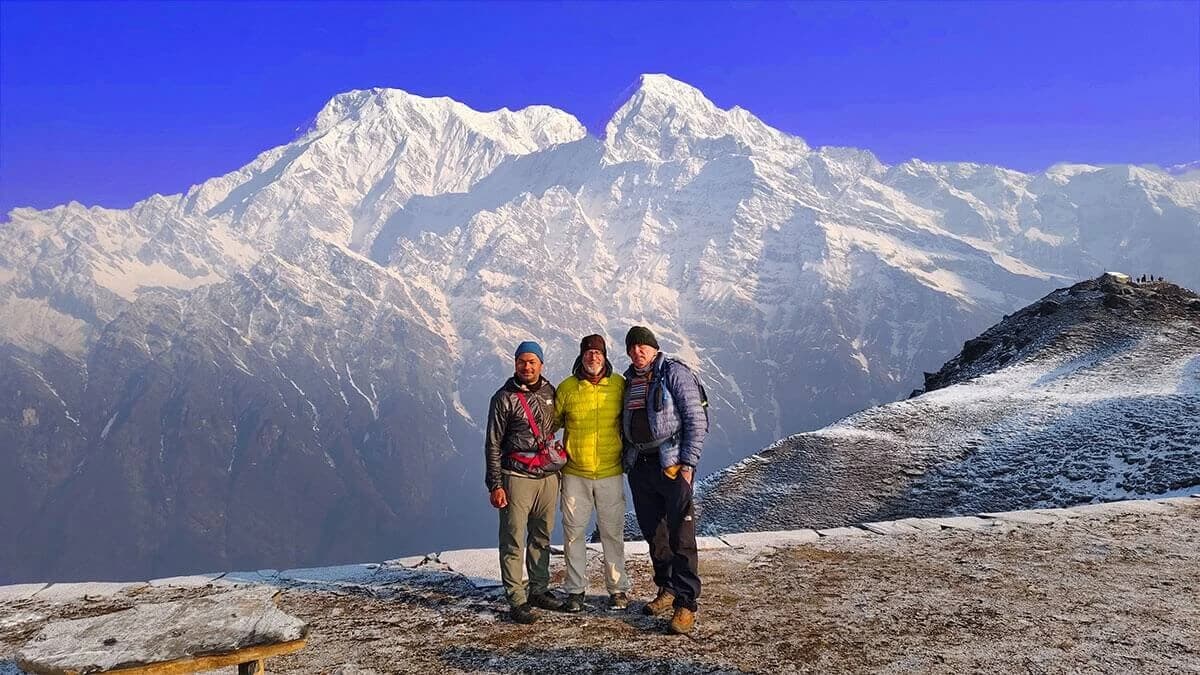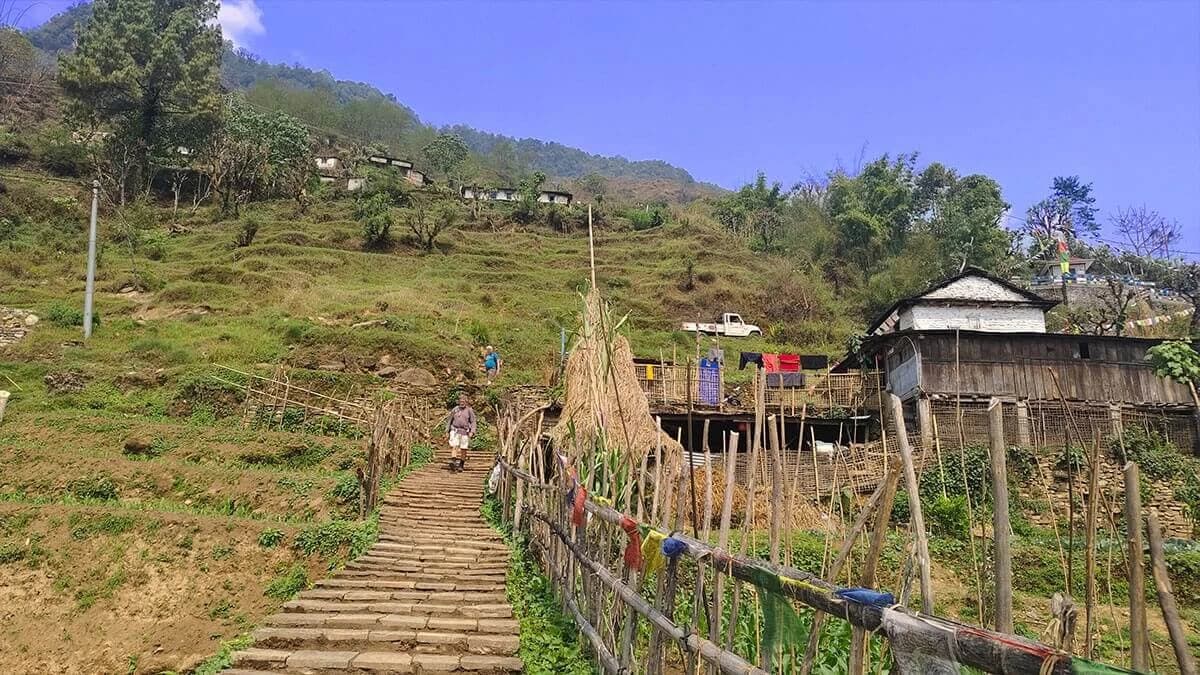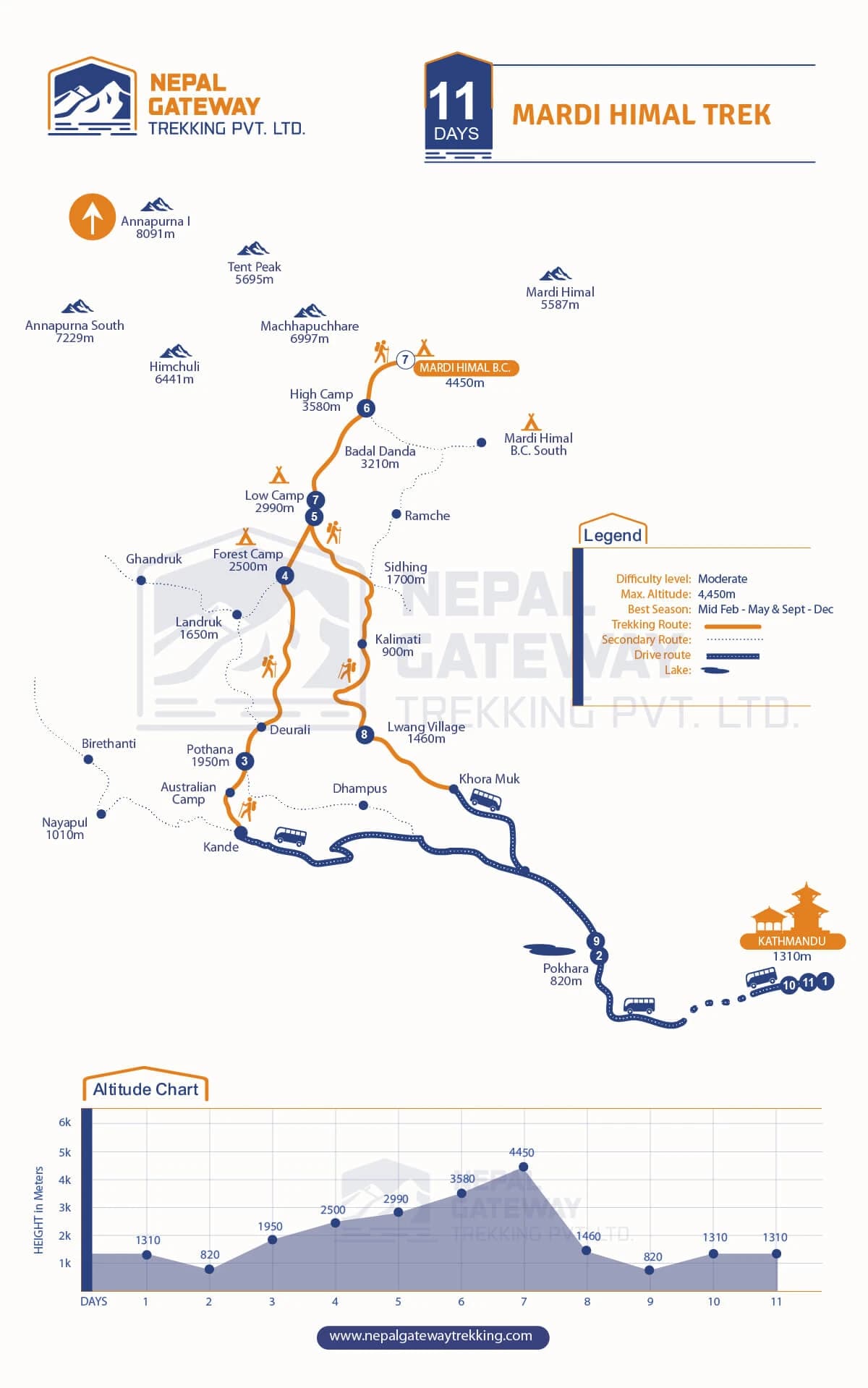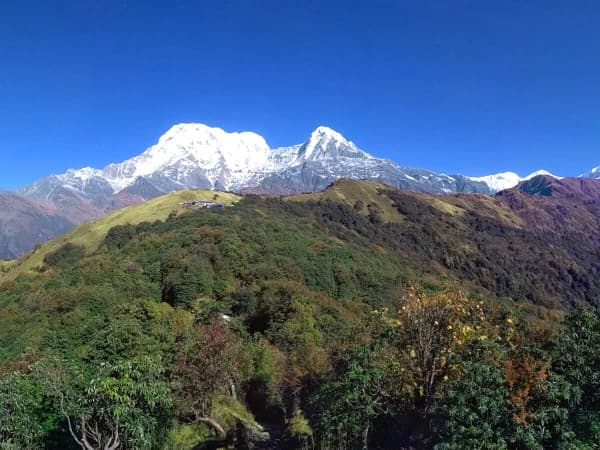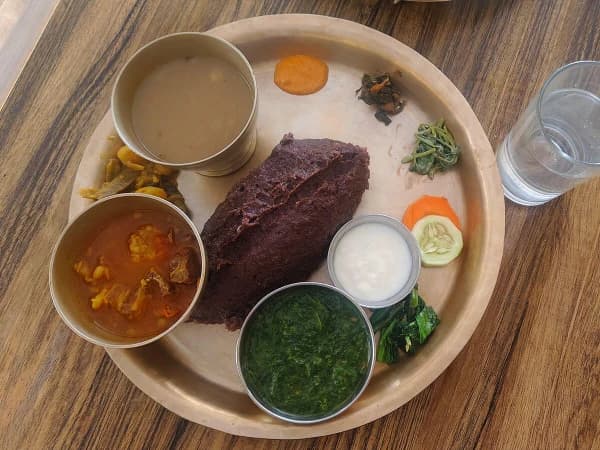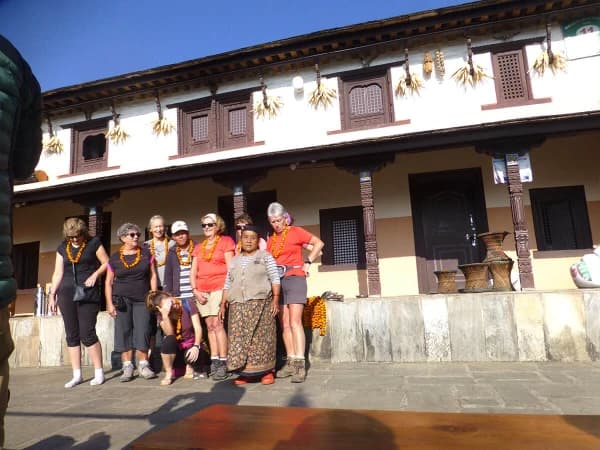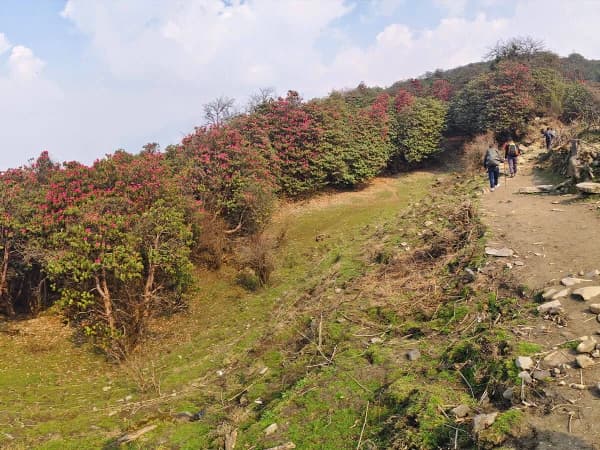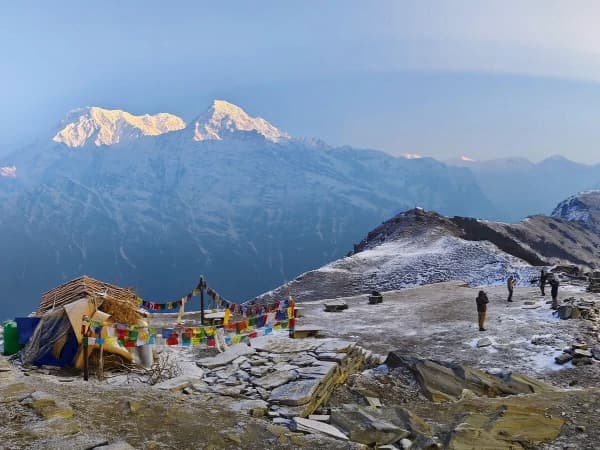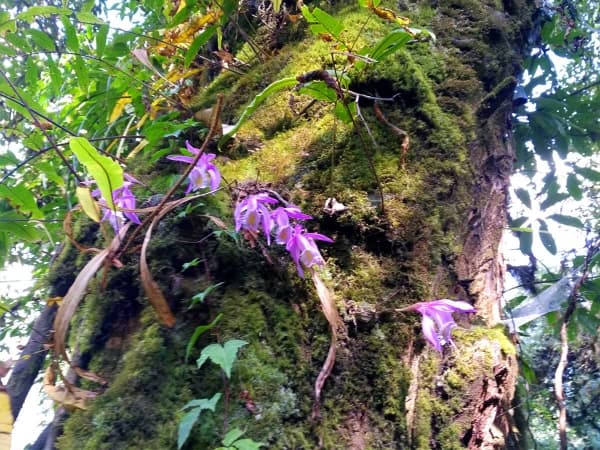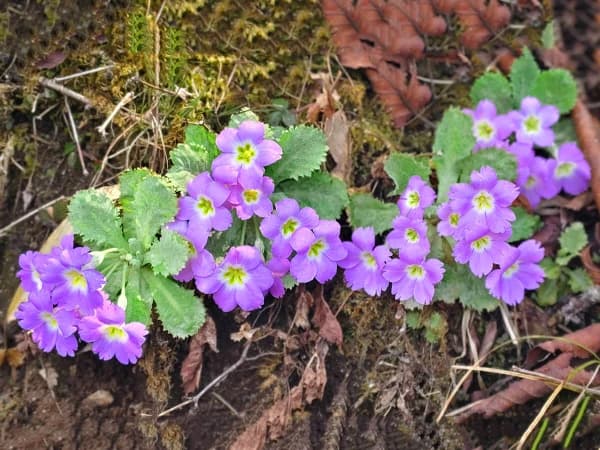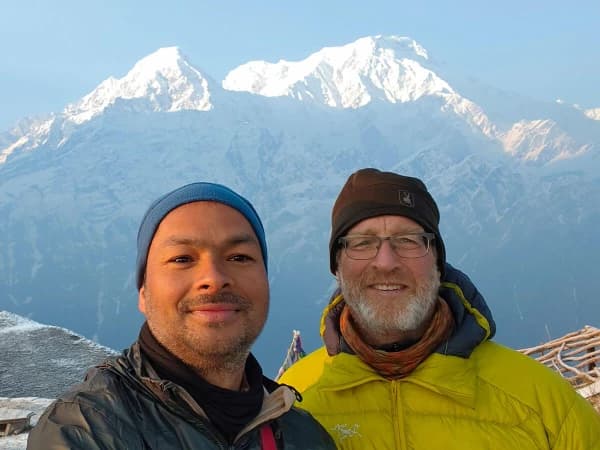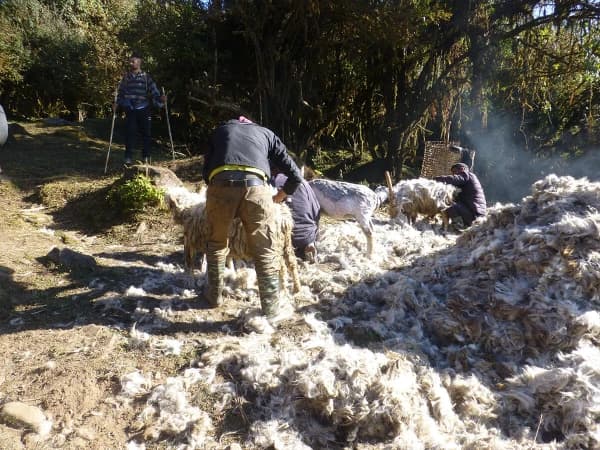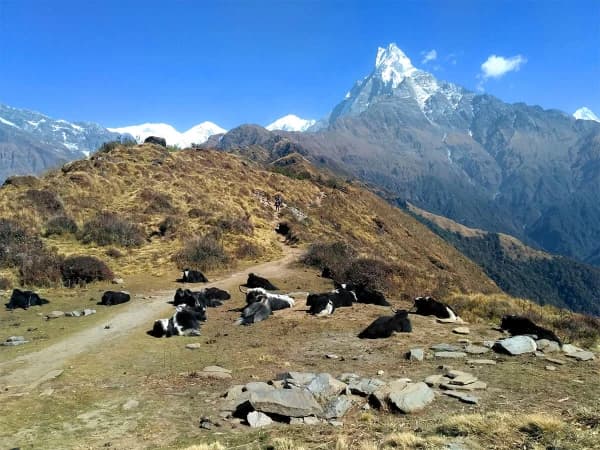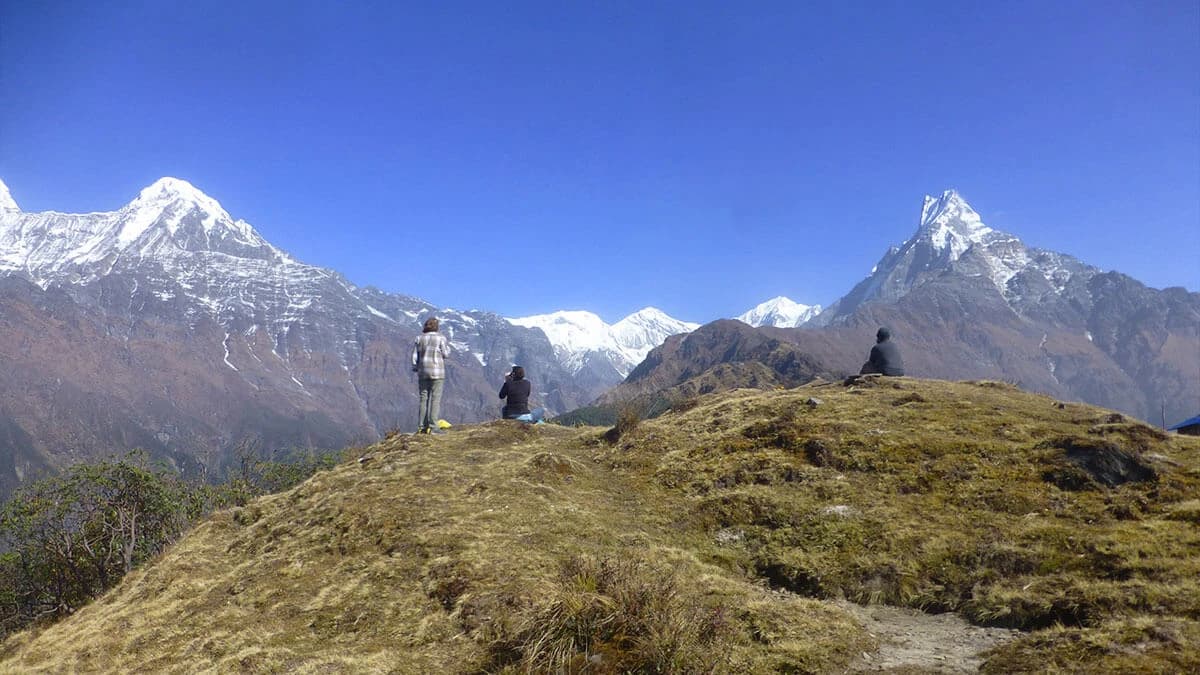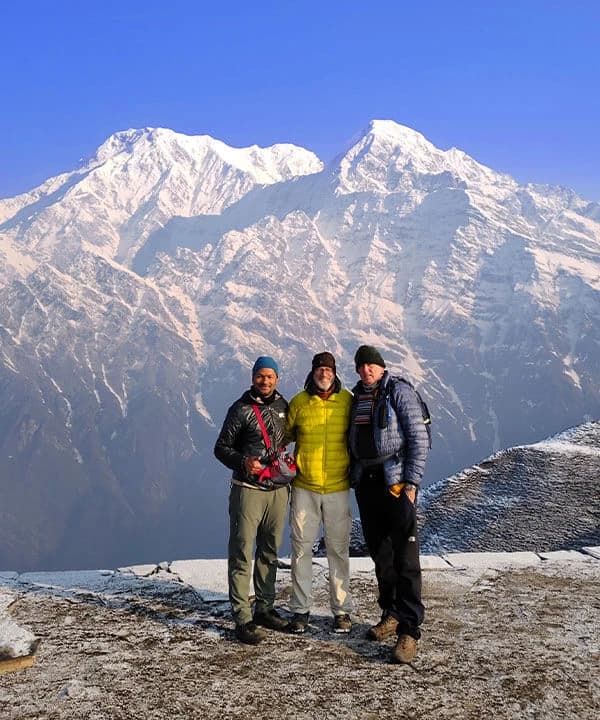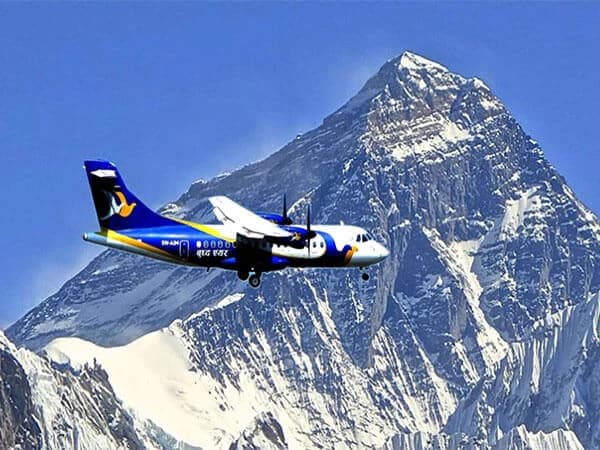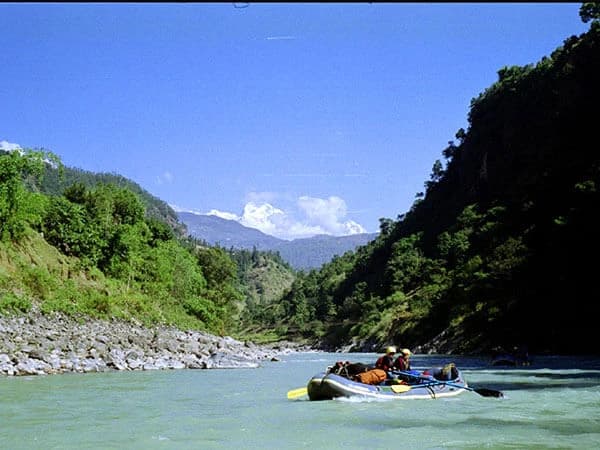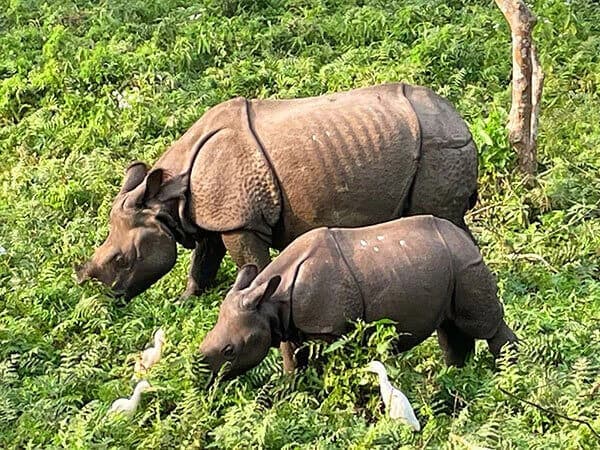Discover the offbeat Mardi Himal Trek in Annapurna—serene trails, stunning Himalayan views, and the untouched beauty of Mardi Himal Base Camp await you.
Mardi Himal Trek
Mardi Himal Trek is often considered Annapurna’s best-kept secret. It is one of the best short treks in the Annapurna region. The trail offers a blend of remote natural beauty and the surreal mountain views of the Himalayas.
The 11-day adventure takes you through the rustic teahouse settlements and dense rhododendron forests. You'll walk through steep-sided valleys, high-altitude ridges, and diverse mountain terrains.
Mardi Himal is a 5,587-meter trekking peak nestled right beneath the towering Machhapuchhre. It was first summited by a British mountaineer/photographer, Basil Goodfellow, in 1961. The trekking route of Mardi Himal was officially opened for trekkers in 2012. The teahouses and lodges are established along the ridgeline towards its summit.
Although short, Mardi Himal Trekking offers a wide variation in the scenery, landscape, vegetation, and climate. The lower section of the trek is dominated by dense subtropical forests with rhododendrons, oak, and juniper trees. The upper section brings an arid landscape with high valleys and soaring mountain views.
The highest elevation point of the Mardi Himal Trek is 4,200 meters at Mardi Himal Upper Viewpoint. From here, you’ll get to relish the stunning up-close view of Machhapuchhre. The views of Mardi Himal, Hiunchuli, and Annapurna South are phenomenal.
The Mardi Himal Trek Route is part of the Annapurna Conservation Area Project (ACAP). Hence, it is home to a large number of wildlife and birds. On your lucky day, you can witness some rare species. You may see Himalayan tahr, blue sheep, Himalayan squirrel, Siberian weasel, and pika.
Likewise, this trekking trail has 152 species of birds. You can witness the striated laughingthrush, yellow-billed blue magpie, fantail, lammergeier, blue whistling thrush, and Himalayan monal.
The Significant Highlights of Mardi Himal Trek
- Relish the marvelous views of Machhapuchhre, Mardi Himal, Hiunchuli, and Annapurna South.
- Catch one of the best sunrises of your lifetime from the Mardi Himal Upper Viewpoint, rising over the high Himalayan peaks.
- Trek along the dense rhododendron, pine, and oak forest and feel nature at its best.
- Stroll around the touristy streets of Pokhara and relax on the shore of pristine Phewa Lake.
- Spend a night in the community-based homestays in Lwang Village and experience the authentic Gurung lifestyle.
- Moderate trek suitable for trekkers of all age groups and experience levels.
Mardi Himal Route Overview
The journey of the Mardi Himal Trek begins with one of the most scenic drives from Kathmandu to Pokhara. The 7-hour drive takes you through countryside villages, local bazaars, terraced fields, and beautiful landscapes.
The next morning, you’ll take a short 45-minute drive from Pokhara to Kande, where you’ll begin the trek. You’ll start by climbing a steep section on the forested path toward Australian Camp. After a short rest, you’ll gradually descend toward your first overnight destination at Pothana.
The following day, you’ll mostly walk under the shades of rhododendron, maple, hemlock, and oak trees to reach Forest Camp. From Forest Camp, the walk continues through the dense forest with occasional views of the soaring mountains on the way to Low Camp.
The route from Low Camp to High Camp brings a drastic variation. You'll leave the treeline behind once you cross the Badal Danda and continue into arid landscapes. The day’s final stretch is a steep and challenging climb as you arrive at 3,580 meters in High Camp.
You’ll begin the hike from High Camp before dawn and head towards the Mardi Upper Viewpoint at 4,200 meters. Enjoy the stunning sunrise view over the towering Machhapuchhre, Hiunchuli, and Annapurna South from the Upper Viewpoint. Then you retrace the route to Low Camp.
From Low Camp, you’ll descend towards the traditional village of Lwang for a community homestay experience. The next day, you hike down to Khora Muk to catch a ride back to Pokhara. You’ll board a tourist bus back to Kathmandu the following day to conclude this memorable adventure.
Why Mardi Himal Trek with Nepal Gateway Trekking?
- Trekking crew with over a decade of experience in leading high-altitude treks to ensure better route navigation and insightful briefings.
- Comprehensive safety standards with a well-paced itinerary, an advanced first-aid kit, and emergency protocols.
- Hassle-free adventure as we handle the entire trek logistics, including itinerary, permit, transportation, accommodation, and meals.
- Comfortable accommodation in Kathmandu and Pokhara on a BB basis. Local teahouse accommodation during the trek on a full-board basis.
- Reduce carbon footprint in the mountain trails with sustainable practices and proper waste management.
- Free Nepal Gateway trekking duffel bag and t-shirt.
Itinerary
This is our standard and recommended Mardi Himal Trek itinerary.
Upon arrival in Kathmandu, a representative of Nepal Gateway Trekking will welcome you at the Tribhuvan International Airport (TIA). He’ll then drive you to a hotel in Thamel and help you with check-in procedures. Head to your room, shower, eat, rest, and recover from the long-hour flight.
In the evening, you’ll have a short team introduction and trek briefing with your trekking guide at the hotel lobby. Please take this opportunity to ask as many questions as possible and clarify things about the days ahead.
After breakfast at the hotel, your guide will meet you in the lobby around 06:30 AM. Take a short walk to the tourist bus stop at Sorakhutte and board a luxury tourist bus to the lake city of Pokhara.
The distance from Kathmandu to Pokhara is 200 kilometers, and it takes roughly 7 to 8 hours to reach. As soon as the bus drives past Nagdhunga Checkpoint, the city’s concrete jungle changes into lush green countryside terrain.
En route, you’ll drive past several local bazaars, traditional villages, terraced fields, gushing rivers, and streams. You’ll reach Pokhara around 3 to 4 PM. Upon arrival, check into your hotel and take a quick shower before heading out to explore the streets of Lakeside and relax on its shore.
On a clear day, you can see the distant view of Machhapuchhre and Annapurna from the streets of Pokhara.
Prithvi Highway Update: The highway is being expanded to four lanes. As a result, there is high traffic congestion and huge dust clouds in several road sections. This may cause a few hours of delays in overland transportation. Please be patient and understand the circumstances accordingly.
After breakfast, you’ll take a 45-minute drive from Pokhara to the small roadside town of Kande. Upon reaching Kande, your guide will conduct an informal briefing regarding the route condition and pacing techniques.
The adventure begins with a steep climb on stone-paved staircases under the shades of dense forest. The trail occasionally expands to remote farmhouses, rice fields, and small villages. After two hours of grueling ascent, you’ll reach the picturesque settlement of Australian Camp.
Located at 2,060 meters, Australian Camp offers a soaring view of Machhapuchhre, Annapurna, and Lamjung Himal to the sky, while the beautiful valley of Pokhara spreads below. Here, you’ll stop at one of the teahouses to enjoy an unhurried lunch with the mountain views.
After lunch, you’ll gradually descend through the rhododendron forest until your overnight destination at Pothana. Settle into your teahouse and take a much-needed rest in the afternoon.
Your day starts with a quick stop at Pothana’s Tourist Checkpoint to verify your ACAP and TIMS permit. Heading out of Pothana, the trails gradually climb through lush green vegetation towards Pitam Deurali.
After a short break, the trail becomes steeper and more challenging than the previous day. You’ll walk under the shade of rhododendrons, magnolia, birch, maple, and oak trees. This route is adorned in beautiful colors during spring, when the flowers and trees bloom to the fullest.
After nearly six hours of steady uphill, you’ll reach the small settlement of Forest Camp. Upon settling in the teahouse, you’ll have enough time to rest and explore the village in the evening.
After breakfast, you’ll continue the adventure with a gentle ascent through the cloud forest covered in moss, lichen, and tree ferns. Although the climb is mostly gradual, a few arduous sections along the route will test your endurance and strength. Make sure to walk slowly and steadily for the sake of your lower back and legs.
As you walk further away from the Forest Camp, the lush trees gradually thin out, occasionally extending the views of Machhapuchhre, Annapurna, and Mardi Himal. The day is relatively short, so you’ll reach Low Camp by lunchtime.
Located at 3,050 meters, Low Camp is a popular lunch or overnight stop en route to Mardi Himal High Camp. Here, you’ll start to feel the cold air of the mountain and increasing elevation. Relax in your teahouse with hot drinks or soups, and keep your body warm and cozy.
Heading out of Low Camp, you’ll continue walking under the shade of rhododendron trees until you reach Badal Danda. Although the climb is moderate, you may start to feel the effect of high altitude on this day. Your trekking guide will constantly remind you to stay hydrated, take plenty of breaks, and maintain your pace.
After a short tea break at Badal Danda, you’ll climb out of the tree line and enter an arid terrain dominated by shrubs and bushes. You’ll continue the ascent on a sharp ridgeline leading to Mardi Himal. The last section that leads to the High Camp is steep and strenuous, but the thrilling view of Machhapuchhre, Mardi Himal, Annapurna South, and Hiunchuli makes the effort worthwhile.
The surroundings change dramatically as you walk up to the high camp. The mountains feel much closer as they become more vivid and visible.
You’ll start the hike before dawn for the glorious sunrise view from the Mardi Himal Upper Viewpoint. Since you’ll be starting in the dark, you must carry a headlamp or torchlight to navigate the route. From High Camp, the path is narrow, steep, and slippery along the high ridgeline.
You’ll walk past a few herder’s shelters used in the summertime to graze goats and sheep from the lower villages. It takes around three hours to reach the Upper Viewpoint from the High Camp. The view from the upper viewpoint is simply otherworldly.
You’ll relish the panoramic view of Annapurna I, Annapurna South, Hiunchuli, Machhapuchhre, Bahara Shikhar, Tent Peak, and Singhachuli.
If you’re still loaded with energy, you have the option to hike to the Mardi Himal Base Camp. Located at 4,500 meters, the base camp is just an hour-long walk from the Upper Viewpoint.
After an unforgettable time at the viewpoint, you’ll head back to your teahouse in the High Camp, where you’ll have enough time to enjoy your lunch and pack your bags. After lunch, you’ll retrace the route back to Low Camp for the overnight stay.
After breakfast, you’ll head out of Low Camp, gradually descending under the shades of the rhododendron forest. Initially, you’ll retrace the route from Low Camp to Forest Camp. Upon reaching Forest Camp, you’ll switch lanes through the terraced fields towards Kalimati.
The trail gradually descends past small settlements, rice fields, and pastures towards the traditional village of Lwang. It takes around one hour to reach Lwang from Kalimati.
You’ll settle in one of the community-based homestays in the village and experience the authentic lifestyle and culture of the Gurung tribe. You can visit the organic tea garden just half an hour uphill from your homestay in the evening and enjoy the sunset view with towering Machhapuchhre and Annapurna in the backdrop.
After enjoying a traditional breakfast with a marvelous view of Machhapuchhre and Annapurna, you’ll begin the downhill hike to the small bazaar of Khora Muk. The walk is relatively gradual alongside the bank of Mardi Khola.
Upon reaching the Khora Muk Bazaar, you and your trekking guide will part ways with the rest of the crew and catch a local jeep to Pokhara. The one-hour drive to Pokhara is relaxing and comfortable.
Once you reach Pokhara, your trekking guide will help you check into a luxurious hotel near Phewa Lake. You’ll have a free afternoon at Pokhara. You can make the most out of the leisure day to explore the city and relax on the shore of Phewa Lake.
You’ll start the day with a hearty breakfast at the hotel with a scenic view of the lake and surrounding mountains. After breakfast, you’ll head towards the Pokhara Tourist Bus Park to board a tourist bus back to Kathmandu.
The 7-hour drive from Pokhara to Kathmandu via the Prithvi Highway is scenic, with lush greenery, stunning mountain views, rivers and streams, and countryside bazaars. Upon arriving in Kathmandu, your trekking guide will transfer you to the hotel in Thamel. After checking in, take your time to shower, clean up, eat, and rest in the afternoon.
In the evening, you can stroll around the bustling streets of Thamel and experience the nightlife of Kathmandu. You can visit the local shops to buy Nepali handicrafts and souvenirs for your family and friends.
This is your final day in Nepal. It is time to pack your bags and head home. One of our representatives will arrive at the hotel lobby precisely three and a half hours before your flight time. He’ll help you with the check-out procedure and transfer you to the airport in a private vehicle for your final departure.
We wish you a safe flight back home and look forward to seeing you soon. If you want to extend your holiday in Nepal, please contact our office so we can make the necessary arrangements.
Dates & Availability
Private tripCost Includes
- All ground transportation as per the program.
- Two nights' accommodation at a three-star category hotel in Kathmandu, including breakfast.
- Two nights' accommodation at a tourist-standard hotel in Pokhara, including breakfast.
- Your three meals (breakfast, lunch, and dinner) and accommodations during the trekking.
- A highly experienced, well-trained, government-licensed, English-speaking trekking guide.
- Required porters (1 porter between 2 trekkers). Porter omits the solo trekker.
- Annapurna Conservation Area Project permit.
- TIMS card (Trekkers Information Management System).
- Mardi Himal Trekking Map.
- Nepal Gateway Trekking Company T-shirt and duffle bags.
- Fresh local fruits as a dessert after your dinner.
- First aid kit.
- All government taxes.
- Office service charge.
Cost Excludes
- Lunch and dinner in Kathmandu and Pokhara.
- Travel insurance.
- International flight tickets to and from Kathmandu.
- The Nepal entry visa fee is quickly issued upon your arrival at Tribhuvan International Airport in Kathmandu.
- All kinds of hot drinks, such as tea, coffee, and hot water, during the Mardi Himal Trek.
- Cold drinks, such as mineral water, coke, fanta, etc.
- Alcoholic beverages during the trek.
- Snacks and desserts (apple pies, chocolate bars, etc.).
- Your first aid kit, equipment, and items of a personal nature.
- Hot showers, internet, and charging fees for mobile phones and cameras unless it is free.
- Tips for trekking staff and drivers. (Tipping is expected.).
Good To Know
Mardi Himal Trek Cost 2026
Mardi Himal Trek is one of the most affordable adventure holidays in the Himalayas of Nepal. The total cost of the 11-day standard Mardi Himal Trek package is USD 780 per person for 2026.
The standard package includes the essentials, including 3-star accommodation in Kathmandu and Pokhara, 6-night teahouse accommodation in the trek, transportation, permit fees, guide and porter costs, meals, etc.
However, if you book the Mardi Himal Trek in a group, Nepal Gateway Trekking will offer a special discount of up to USD 120 per person, depending on your group size. Since there are no luxury lodges along the Mardi Himal route, there’s no option to upgrade the teahouse accommodation during the trek.
However, you can upgrade the transportation option (to and from Pokhara) from a luxury tourist coach to a private vehicle. Depending on the car, you may need to add an extra USD 200 to upgrade the road transportation. Moreover, if you want a more comfortable and time-saving option, you can upgrade the two-way transportation to commercial flights for an extra USD 200 to 250 per person.
Permits required for Mardi Himal Trekking
You need the two government trekking permits for the Mardi Himal Trekking. They are Trekkers’ Information Management Systems (TIMS) and the Annapurna Conservation Area Project Permit (ACAP).
These permits will be checked and verified at the Tourist Checkpoint in Pothana.
-
Trekkers’ Information Management Systems (TIMS)
The TIMS Card is a mandatory trekking permit introduced in collaboration with the Nepal Tourism Board (NTB) and TAAN. This permit is meant to ensure the safety and security of the trekkers through registration checkpoints and manage their flow.
Moreover, the fees collected by TIMS Card go towards the insurance of local guides and porters.
Where can you get the Trekkers’ Information Management Systems (TIMS)?
You can get this permit from the NTB and TAAN offices in Kathmandu/Pokhara. The TIMS Card costs NPR 2,000 for foreigners and NPR 1,000 for SAARC nationals.
-
Annapurna Conservation Area Project Permit (ACAP)
Annapurna Conservation Area Project Permit (ACAP) is mandatory for all treks within the Annapurna Conservation Area (ACA). The permit is valid for a single entry and exists. The permit fee contributes to the ACA’s environmental preservation, tourism promotion, and social development.
Where can you get the Annapurna Conservation Area Project Permit (ACAP)?
You can get this permit from the NTB office in Kathmandu/Pokhara or the park entry gate at Pothana. The ACAP permit costs NPR 3,000 for foreigners and NPR 1,000 for SAARC nationals.
How difficult is Trek to Mardi Himal?
Trek to Mardi Himal View Point is a short and moderate trek in the high Himalayas of the Annapurna region. Although this trek does not involve direct climbing or mountain pass crossing, you must walk over rocky and steep terrains near High Camp and Upper Viewpoint.
Besides that, the Mardi Himal Trek involve 5 to 7 hours of slow walking with an average ascent of over 500 meters. The entire trek covers roughly 64 kilometres, with over 400 kilometres of bus travel from/to Kathmandu.
The most challenging section of the Mardi Himal Trek is a 3-hour hike from High Camp to Upper Viewpoint. Likewise, the downhill to Low Camp and Lwang village is also quite steep, often catching trekkers’ knees.
In the 11-day Mardi Himal Trek itinerary, you’ll spend only three nights above 3,000 meters. You spend two nights at Low Camp (3,050 meters) and one night at High Camp (3,580 meters).
Moreover, you’ll spend less than an hour at 4,200 meters at Mardi Himal Upper Viewpoint. So, high-altitude sickness isn’t much of a concern in the Mardi Himal Trek.
As a short and moderate trek, Mardi Himal is an excellent option for trekkers with little to zero trekking experience.
Training for Short Mardi Himal Trek
Although this trek is moderately challenging, a few arduous sections require a decent fitness level. You do not need to train like a professional athlete or bodybuilder. You must be comfortable to hike for 5 to 7 hours with a decent-size backpack on rugged terrains, steep sections, and adverse weather.
You should start training at least 4 to 6 weeks before heading to Mardi Himal. Here are a few training tips to improve your fitness level for this trek.
- Engage in steady-state cardio and aerobic exercises such as jogging, running, swimming, rowing, and rope jumping. These exercises help improve your cardiovascular health, stamina, brain function, lung capacity, and overall immune system. Cardio workouts also help improve muscle strength around ankles, knees, and hips, ensuring better joint support and reducing the risk of injury.
- Add exercises that strengthen your core and upper body muscles in your training regimen. A strong core enhances balance, stability, posture, body alignment, and functional movement. Likewise, upper body exercises develop muscles in the shoulders, arms, back, and chest, allowing you to carry a backpack for a long period on uneven surfaces. Besides that, these exercises help you recover faster, support energy expenditure, and prevent injury during the trek.
- Add at least two days of leg-focused workouts each week. Leg workouts strengthen glutes, hamstrings, quads, and calve muscles, helping you overcome steep and uneven terrain. These exercises also improve your stability and balance, support joint health, enhance flexibility, and reduce post-trek soreness.
- Incorporate regular stretching into your workout routine to enhance the range of motion in your joints and muscles. Add a 30-minute stretching routine before your daily workout to improve blood circulation, boost mental endurance, maintain proper posture, reduce joint stiffness, and prevent injury.
- If there are hiking trails near your hometown, we recommend that you occasionally go for conditioning hikes. Start slowly with short-distance walks around the area. After a couple of weeks, gradually increase the distance, intensity, and duration. Wear your hiking boots and carry a weighted pack to replicate similar conditions if possible.
When is the Best Time for Trekking to Mardi Himal View Point?
There is no denying that the season directly affects weather conditions, trail conditions, crowds, and the overall trekking experience. While it is possible to trek to Mardi Himal View Point all year long, each season brings a few ups and downs.
Autumn (September to November)
Autumn brings the perfect weather for trekking to Mardi Himal. The weather mostly remains stable, with moderate temperatures, low precipitation, and gentle wind.
As monsoon rain clears the sky of dust during this time of the year, the skies are bright and clear, with splendid views of mountains, landscapes, and nature. Likewise, the forest section in the lower reaches of the Mardi Himal Trek stays monsoon-like green and lush.
While the trek is relatively enjoyable, the only downside of trekking in autumn is the crowded trail. Note that Mardi Himal Trek has become quite popular among domestic tourists in the past few years. Most of them choose to travel during this time of the year, as it coincides with the holiday season in Nepal (Dashain and Tihar).
Spring (March to May)
After autumn, spring is the second best season to trek to Mardi Himal. This is the end of the harsh winter in Nepal. Hence, the temperature remains moderate and dry during this time of the year.
The sky, with unobstructed mountain views, is bright and clear in the mornings. The thick cloud cover and poor visibility prevail in the afternoon. However, the trails in the upper sections are snow-free, making the walk more comfortable and enjoyable.
In addition to mountain views, spring is the best time to admire this region’s greenery and blooming. The blooming rhododendrons and colorful wildflowers are remarkable to notice. The lower sections of the Mardi Himal Trek are covered in rich hues of rhododendrons, orchids, magnolias, and primroses.
Winter (December to February)
Winter is a less popular time to trek to Mardi Himal. It brings extreme cold and harsh weather, especially in the upper sections. On a sunny day, the daytime temperature in these regions is tolerable. The nights can often get extreme, with temperatures dropping as low as 0°C or even minus.
It is common to have snowfalls in the areas above Low Camp, covering the trails in thick snow. Moreover, the steep section from High Camp to Upper Viewpoint can be tricky during the winter. The snow makes the trail slippery and increases the risk of missteps.
Having said that, a handful of courageous trekkers favour winter over other seasons. Despite the cold, the snow-covered mountains and landscapes bring a different magic that excites a few trekkers. The trails are almost empty during this time of the year, bringing a sense of peace and solitude.
Monsoon (June to August)
Monsoon is the least favoured season for trekking to Mardi Himal. It brings heavy rainfall, resulting in wet, muddy, and slippery trails. Constant showers and thick fog can also affect visibility in the upper section of the trek. It will make the walk more challenging and difficult because of slippery.
During monsoon season, the lower regions of the Mardi Himal Trek are infested with leeches. Therefore, we recommend wearing long trousers, high socks, and high-neck shoes.
However, the valleys and forests breathe a different life during the monsoon season, with lush greenery and blooming wildflowers. Unlike peak trekking seasons, you can enjoy empty trails during this time of the year.
Acclimatize and Safety for the Mardi Himal Trek Route
The highest elevation point of Mardi Himal Trek Route is 4,500 meters at Mardi Himal Upper Viewpoint. Although there is a risk of high-altitude sickness at such high elevation, you’ll only spend a short time at the Upper Viewpoint.
Therefore, acute mountain sickness (AMS) risk is significantly less in the Mardi Himal Trek. Regardless, you must not neglect the elevation and consider a few things to acclimatize naturally. These help to make your journey to Mardi Himal more comfortable.
Things You Should Do
- Walk slowly and steadily to let your body acclimatize naturally in the thin air.
- Drink at least 3 to 5 litres daily to keep your body hydrated in the mountains.
- Avoid cigarettes, alcohol, and other stimulants that result in dehydration.
- Losing your appetite at high altitudes is common. You should eat a proper diet to replenish your body with essential nutrients and calories.
- If you experience any symptoms of high-altitude sickness, inform your trekking guide right away. He can assess your health condition and take the appropriate action.
Accommodation on Trek to Mardi Himal View Point
We’ll provide comfortable 3-star accommodation during your stay in Kathmandu. We provide tourist-standard hotels in Pokhara. These hotels offer high-class amenities, including comfortable bedding, en-suite bathrooms, and air conditioning in the room. They have an in-house restaurant and dining area, etc.
While on the trek, you’ll settle in local teahouses for overnight accommodation. The teahouses in Mardi Himal Trek are relatively basic since this trekking route officially opened for trekkers just over a decade ago.
The number of teahouses and lodges in the Mardi Himal route has increased significantly in the last few years. The newer teahouses are slightly better equipped than the older ones, but the upgrade is somewhat marginal.
The rooms in the teahouses are small and cozy. The rooms are with twin or multiple beds, warm blankets, comfortable pillows, and foam mattresses. They do not have in-room heating facilities. Almost all teahouses in Mardi Himal have a shared toilet and shower section.
Note: All accommodations (in Kathmandu, Pokhara, and during the trek) are on a twin-shared basis. If you do not prefer to share the room, we can arrange a single supplement for an additional cost. However, this may not always be possible, especially in the upper part of the trek, due to the limited number of rooms.
Meals during the Mardi Himal Hike
Our standard package includes breakfast at hotels in Kathmandu and Pokhara. Your three meals a day (breakfast, lunch, and dinner) during the trek. Breakfast and dinner are usually served at the teahouses where you stay, and lunches are served en route.
Compared to other commercial treks in Nepal, the food options in the Mardi Himal Trek are limited. The menu combines typical Nepali foods with a few continental dishes.
Dal Bhat is the staple, while momo and chowmein are the favourites. Other local delicacies include thukpa, fried rice, noodles, chapati, and Tibetan bread. Likewise, continental options include sandwiches, pancakes, and pasta.
The beverage options include milk tea, black tea, instant coffee, soft drinks, ginger tea, lemon tea, and hot juice.
Drinking Water Condition in Mardi Himal Hiking Route
Tap and boiled water are commonly available in the teahouses of Mardi Himal. Although the locals drink directly from the tap, you should always consider treating the water before drinking it. Untreated or unfiltered water is known to cause water-borne diseases, which can ultimately ruin your trek.
Invest in a decent water bottle with a straw filter to remove bacteria, protozoa, and microplastics from water. You should further use chlorine—or iodine-based water purifiers to ensure the water is safe to drink.
The teahouses also provide boiled water for a nominal fee of USD 2 to 4 per liter. Although boiled water is considered safe to drink, we suggest you use purification tablets or drops.
Bottled water is also available in every lodge and teahouse of Mardi Himal. You can buy bottled water for USD 2 to 4 throughout the trek. However, we do not recommend buying bottled water as it is not sustainable or environmentally friendly.
Hot Shower Facilities en route to Mardi Himal
Hot showers are available in every teahouse en route to Mardi Himal. Until Forest Camp, the teahouses provide gas—or solar-powered hot showers. Once you go past Forest Camp, there is no running hot water for showers. If you want to go for a full wash during the trek, you must make do with a bucket bath.
Hot showers cost up to USD 4 in the lower reaches and up to USD 6 in the upper reaches.
Mobile Network and Internet Connectivity
Mobile network coverage is available for NTC and Ncell along the Mardi Himal route. Signal strength is decent in the lower reaches of the trek until Forest Camp. Once you walk past Forest Camp, it becomes weak, irregular, and nonexistent at times.
You can expect 3G data coverage in sections with decent signal strength. However, it can be unreliable and spotty in higher altitudes as the mobile network depends highly on weather conditions.
All teahouses and lodges in Mardi Himal offer Wi-Fi services for a nominal fee of USD 2 to 5 per device. However, the signal can often be poor and infrequent due to the remoteness and weather conditions of the region.
Electricity
Electricity is accessible along the entire route of Mardi Himal. The teahouses until Forest Camp are powered by hydroelectricity. So, charging your mobile phones and other devices is not a problem in the lower section.
After Forest Camp, the teahouses rely on solar-powered electricity. In bad weather, the electricity may not be available in the upper section. So, carrying a high-capacity power bank to charge your devices is advisable.
The rooms in the teahouses do not have charging sockets, so charging your devices in the room is not possible. Instead, the teahouses have a common charging station in the dining room, where everyone plugs their devices.
There is a nominal fee of USD 2 to 5 to charge your mobile phone and other devices.
ATMs and Money Exchange
Since most lodges and teahouses in the Mardi Himal only accept local currency, i.e., Nepalese Rupee (NPR), you must carry extra cash for personal expenses during the trek.
Note that there are no money exchange centers or ATMs on the route to Mardi Himal. Hence, you must exchange foreign currency or withdraw cash before heading to the mountains.
There are plenty of money exchange centers and ATMs in the touristy areas of Kathmandu and Pokhara. If you plan to exchange foreign currency, we recommend doing so in Kathmandu for a better exchange rate.
Travel Insurance
Mardi Himal is a moderately demanding trek with minimal risk of acute mountain sickness. However, it involves walking on high-altitude, rough terrain for almost a week.
During the trek, you may encounter several unforeseen events, such as accidents, illness, physical injuries, etc. Therefore, it is mandatory to have a travel insurance policy when signing up with Nepal Gateway Trekking.
Here are a few things your travel insurance must cover:
- The cost of emergency medical transport, i.e., helicopter or ambulance.
- Medical coverage for general illness, physical injuries, and acute mountain sickness.
- Reimbursement on prepaid expenses and flight change/cancellation fees.
- The cost of stolen or lost items during the trek.
- Elevation coverage for trekking up to 4,500 meters.
Guide and Porter Information
Nepal Gateway Trekking takes pride in providing highly skilled guides and porters in all our treks and expeditions. Our guide and porters have extensive knowledge of the region. They have over a decade of experience leading trips in the high Himalayas of Nepal.
For the Mardi Himal Trek, we’ll provide a professional, English-speaking guide who can help you navigate the region. He also shares valuable insights on its history, culture, and geography.
Besides, all our guides are well-trained and certified to handle emergencies. They all can handle high-altitude sickness, accidents, minor injuries, illness, etc.
We consider our guides and porters as an integral part of our team. Therefore, we ensure they’re treated fairly and receive much-needed support at every step. We pay our guides and porters above industry standards and provide high-end gear for all our treks.
Gratitude to the Trekking Crew
There is no doubt that the trekking guide and support crew are the unsung heroes who effortlessly contribute to making the Mardi Himal Trek successful. You can make several small gestures to show gratitude and acknowledge the team’s hard work and dedication.
- Although tipping is not mandatory in Nepal, it is highly appreciated. It is a great way to express your gratitude and support their livelihood.
- To show appreciation to the crew members, you can buy or donate items like warm jackets, boots, trekking accessories, etc.
- Write positive reviews about the crew members on online platforms like TripAdvisor and Google Reviews. You can add their names and contact details so they can attract more clients in the future.
- If your family or friends plan to trek in the Himalayas of Nepal, make a small effort to recommend your trekking crew and help them secure more work.
- On your last day in Pokhara or Kathmandu, invite them to lunch or dinner and express your gratitude in person.
Mardi Himal Trek Blogs
FAQs
Mardi Himal Base Camp is situated in the Annapurna region, Gandaki zone, near Pokhara. It is located on the east of Annapurna Base Camp.
Mardi Himal Trek is 10–11 days long, including arrival and departure day in Kathmandu. It is one of the short trekking packages in the Annapurna region.
Yes, you need a permit for the Mardi Himal Hike because it is part of the Annapurna Conservation Area Project (ACAP). You need to obtain an ACAP permit, which costs NPR 3000 per person. The Nepal Tourism Board in Kathmandu or Pokhara issues the ACAP permit.
The best times for doing the Mardi Himal Trek are March to May and October to November. March to May is the spring season in Nepal. You will experience beautiful rhododendron-blooming forests with stunning views of Mount Fishtail - Machhapuchhre, a native name.
Autumn (October-November) is another best time for the Mardi Himal Hike. Autumn is right after the monsoon season. The sky is usually clear and offers sunrise and sunset views in the Himalayas.
Mardi Himal Trekking Route is a moderate trekking trail in Nepal. The beginning section of the trek to Low Camp is a moderate climb. However, it is steeper to Mardi Himal Viewpoint from Low Camp via High Camp and steeper down while returning to Low Camp.
The standard cost for Mardi Himal Trekking will be around USD 700 to 800. The price for the Mardi Himal Package can be more or less based on your requirements. The price depends on the number of trekking days, hotel category, transportation mode, etc.
To reach Mardi Himal Base Camp on the Mardi Himal Trek route, you must first drive or fly to Pokhara from Kathmandu. From Pokhara, you must drive to Kande to start your hike to Mardi Himal. You will walk through small settlement villages in Annapurna, including Forest Camp, Low Camp, and High Camp, to reach Mardi Himal Base Camp.
You can also drive to Sidding from Pokhara and trek to Mardi Himal Viewpoint for stunning views of Mount Fishtail.
There have been a few cases of individual trekkers being abandoned on this Mardi Himal Trekking route. So, we recommend you go with an experienced guide on Mardi Himal. It is a safe journey for you with no hassle to find a place to sleep with a guide.
The standard itinerary is 6-7 days from Pokhara to Mardi Himal and back to Pokhara. However, if you want to do it in a shorter time frame, you can hike in 3-4 days, too.
Traveler’s Experience with Us?
My friends and I reached out to Raj and Ram to help us arrange our trekking trip in Nepal. They gave excellent recommendations and planned...
I've been trekking with Raj for almost a decade now. He always organises excellent, professional trips. He has expert guides for each region and makes...
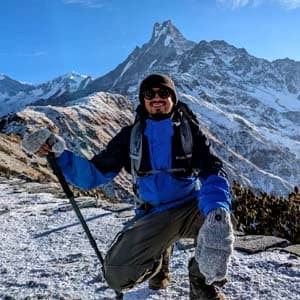
Just go with Gateway and Ram, you will not be disappointed! We did treks to Langtang Valley, Poon Hill/Mardi Himal and got turned around on...


